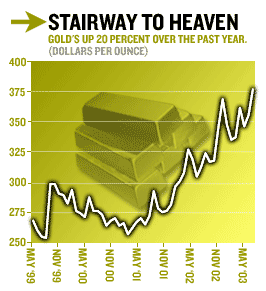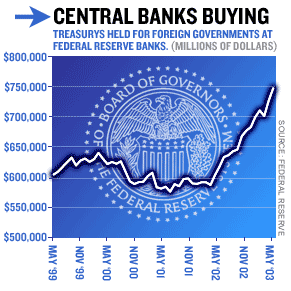NEW YORK (CNN/Money) - Gold has been soaring lately and observers have been reaching for reasons behind the move almost as avidly as investors have been reaching out to get a hold of the glittery stuff.
Gold is up because investors are becoming wary about inflation and are looking for a hedge. Gold is up because the bombing in Mumbai made heavy Indian demand even heavier. Gold is up because China's central bank is going to start buying more of it.
But it may be that the strength in gold, which jumped $29 to $375 an ounce over the past month, owes less to any specific event than it does to countries around the world fighting to keep their currencies weak. Because currencies can't weaken against each other in the world of competitive devaluations, they must weaken against other things. Gold, because it shares the characteristics of both a currency and a commodity, fits the bill nicely.
"You can sort of think of it as a tide going out," said Rhodes Analytics head Bill Rhodes. "Gold isn't affected by the tide, because it isn't a fiat currency. So when the value of currencies drops, it emerges as a big rock."
Lovely image, but how does it work in the real world?

The starting point is to look at the U.S. dollar, because if there is one major currency that deserves to be weaker, the greenback is it. Nearly half the respondents in Merrill Lynch's latest fund manager survey thought the dollar was overvalued versus just 14 percent who thought it was undervalued -- a view that most economists heartily agree with.
But a weak greenback is not something that the world's economies, many of which are hugely dependent on exports to the United States for growth, want. Front and center is Japan, which has regularly intervened in the currency markets this year in an effort to keep the yen from strengthening.
In a bit of finger pointing, Japanese officials say they have to keep the yen weak because China has its currency, the yuan, pegged to the dollar at unnaturally low levels. The yuan peg has also angered other Asian countries (many of which have reacted by working to drive their currencies lower) and U.S. manufacturers -- all of them say it gives China an unfair competitive advantage because it allows it to sell its products cheaply.
"Nobody wants a strong currency, and since the U.S. currency is fundamentally weak, foreign central banks need to buy up dollars to keep their currency from appreciating," said Northern Trust chief U.S. economist Paul Kasriel.

When a central bank weakens its currency by buying dollars, it is left with a bunch of greenbacks on its hands that it has to do something with. The easiest place to put them is Treasurys. China, to keep its dollar peg, ends up doing the same basic thing. The footprint of all this activity can be found in Federal Reserve statistics on foreign Treasury holdings. Through June -- the last month there are statistics available for -- foreign official Treasury holdings at Federal Reserve banks had a face value of $747 billion. That's nearly $130 billion more than in the previous June -- the smoking gun of an unprecedented amount of dollar buying.
It's easy for central banks to come up with the money to buy dollars of course -- they all own printing presses. So a side effect of their dollar buying is that there's more of their home currencies in circulation. And when there's more of something, it tends to cheapen in value. Gold, on the other hand, exists in only limited supply. For investors, that makes the choice between gold and currency easy to make: They'll take the gold.
"Since central banks aren't letting their currencies appreciate against the dollar, that implies that all the currencies will depreciate against gold and commodities in general," said Kasriel.
The end result will be inflation -- much more of it, thinks Kasriel, than the Fed and other central banks are currently bargaining for.

|

